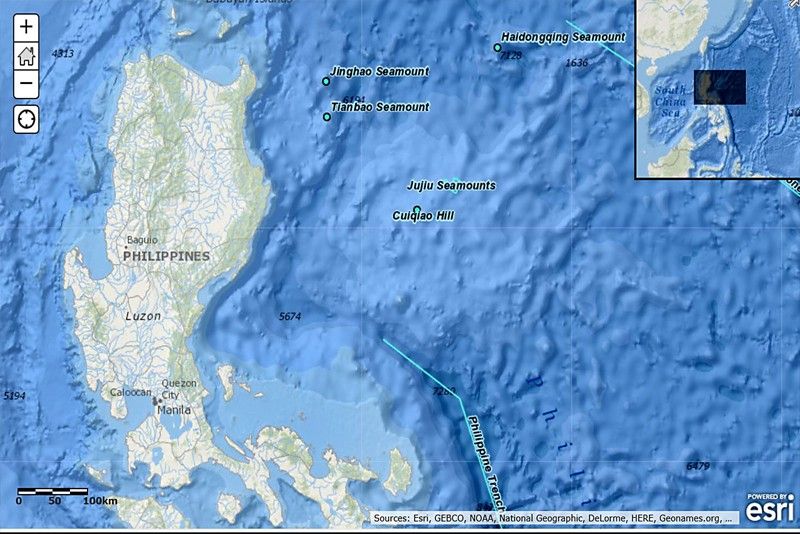China wants to name 142 ocean features

A map, viewed using mapping tools from the National Centers for Environmental Information, shows the location of the undersea features in Benham or Philippine Rise that were named by China from 2014 to 2016. Details on undersea feature names were sourced from the General Bathymetric Chart of the Oceans.
MANILA, Philippines — The Chinese names given to five undersea features in Benham or the Philippine Rise were just the tip of the iceberg, The STAR has learned.
In what some quarters see as a bid to cement its status as a maritime power, Beijing has proposed names to other undersea features in the South China Sea (SCS) and the Pacific Ocean, including in areas where China has territorial disputes with other countries.
Documents from the Sub-Committee on Undersea Feature Names (SCUFN) of the International Hydrographic Organization (IHO) showed that China has proposed names to 142 undersea features worldwide since 2013.
The number of proposals made by China significantly increased in recent years, rising from 10 in 2013 to 19 in 2014, 21 in 2015, 50 in 2016 and 42 last year.
Most of the features are located in the Pacific Ocean, although a number are also in the South China Sea, Atlantic and Indian Oceans.
Out of the 142 proposals, the SCUFN approved the names for 84 undersea features, including the five in Philippine Rise, which was declared part of the Philippine continental shelf in 2012.
Jay Batongbacal, director of the UP Institute for Maritime Affairs and Law of the Sea, said China’s move to name undersea features appears to be part of its overall policy to demonstrate its capabilities.
“They are showing what they can do in terms of maritime research and exploration,” he told The STAR in a phone interview last Friday.
It was Batongbacal who first revealed China’s proposal to name five undersea features in Philippine Rise in recent years.
While this is not prohibited based on SCUFN rules, Batongbacal criticized the Philippine government for failing to act on proposals to name undersea features inside Philippine territory.
“We discovered these features in the course of making the extended continental shelf claim. (The National Mapping and Resource Information Authority) had proposals to name features using names of Filipino trees and birds,” he said.
“Leadership sat on the recommendations. The technical people knew about the naming proposals and made recommendations for action. Leadership sat on them as well,” he added.
He also noted that some of the proposals in Philippine Rise were made by the Chinese Ocean Mineral Resources Research and Development Association, raising concerns over the possible exploitation of resources in the region.
While no Filipino is sitting at the SCUFN, the Philippines is a member of the IHO and could submit proposals, according to Batongbacal.
‘Politically sensitive’
Based on IHO documents, China first proposed naming features in Benham Rise in 2014 when it sought to name the Gongchou and Haidongqing Seamounts.
The SCUFN approved the proposal for Haidongqing but declined to name the other feature as Gongchou as it is already known as Vinogradov Seamount.
China proposed to name three more areas in Benham Rise in 2015: Jinghao, Qiangde and Tianbao Seamounts. It later withdrew the proposal for Qiangde, while the committee approved the proposals for Jinghao and Tianbao.
In 2016, China resubmitted its proposal for Qiangde, and added proposals for Cuiqiao, Jujiu, Mingyue and Sata Seamounts.
The SCUFN approved the proposals for Cuiqiao and Jujiu, but then postponed after some members raised concern over the procedures of naming undersea features near coastal countries that may have interests in the area.
The postponement was also applied to 20 other Chinese proposals to name features in disputed areas in the South China Sea.
During discussions in the SCUFN meeting in Italy last year, a proposal was made to the committee’s term of reference to facilitate discussion on names for features that are politically sensitive or controversial.
“The sub-committee will not consider undersea feature name proposals that may be considered politically sensitive or controversial. In reaching any decision not to consider certain proposals, the chair shall take into account views of the members of the sub-committee,” read the proposed amendment.
The committee said the proposal would keep its members from being involved in political considerations.
While this would address naming of politically-sensitive features, Batongbacal said this will not stop China from making similar proposals in the future.
During last year’s meeting, China’s representative Lin Shaohua said they would resubmit proposals that were postponed in 2016 in future SCUFN meetings.
No undersea feature in Philippine Rise was included in the proposals made by China last year.
However, it included three undersea features in Western Pacific Ocean that are on the eastern part of the Philippine Basin. These are beyond the extended continental shelf of the Philippines.
Ruling on the three proposals, the SCUFN approved the name Huaixu and Shouyang Ridges, but put in pending status the proposal for Jixia Hill.
China also succeeded in naming 10 undersea features in the South China Sea, although none appears to be within areas that the Philippines also claims.
Naming undersea features
According to China, its proposals to name undersea features are their contribution to the global efforts to map oceans worldwide.
It established in 2010 the China Sub-Committee on Undersea Feature Names to review proposals that would be submitted to the SCUFN.
“In recent years, China has been actively keeping up with the progress in the international undersea feature naming work,” read a document released in time with the 50th year of the United Nations Conferences on the Standardization of Geographical Names.
“China carries out the research on the naming principles of general and proper names,” it added.
Other countries that proposed undersea feature names in recent years include Japan, Canada, South Korea, New Zealand, US, Russia, Brazil and Palau, among others.
The Philippines has not made any proposal to the committee in the past five years.
Batongbacal urged the Philippine government to propose names, especially in undersea features within the country’s territory.
“I do explain in interviews that naming doesn’t have an impact on sovereign rights. What I do raise is the government inaction on this,” he wrote in a post in his Facebook account.
“The blame largely rests on us. Aquino or Duterte administration, both are at fault, as far as I am concerned. Official arguments based on error do not help at all, and make it worse,” he said.
- Latest
- Trending





























